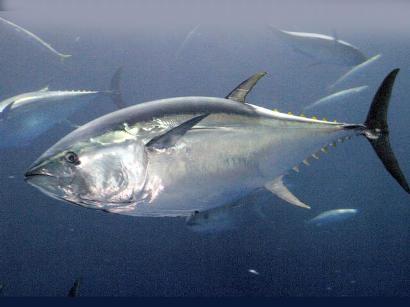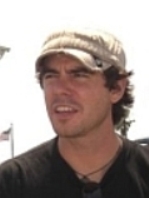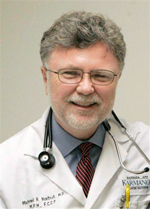Low levels of Fukushima cesium found in West Coast tuna
西海岸のマグロに見られる低レベルの福島セシウム
Scientists hope to test new samples of Pacific blue fin tuna after low levels of radioactive cesium from Japan's Fukushima Daiichi nuclear accident turned up in fish caught off California in 2011, researchers reported Monday.
科学者たちは、2011年に捕獲された魚から福島放射能事故からのセシウムが見つかった後、太平洋のマグロの新しいサンプルを検査したいと思っている、と調査員は月曜日に報告しました。

The bluefin spawn off Japan, and many migrate across the Pacific Ocean. Tissue samples taken from 15 bluefin caught in August, five months after the meltdowns at Fukushima Daiichi, all contained reactor byproducts cesium-134 and cesium-137 at levels that produced radiation about 3% higher than natural background sources - but well below levels considered dangerous for human consumption, the researchers say.
クロマグロは日本沖で卵を産み、多くが太平洋を渡ります。福島のメルトダウンから5ヵ月後の8月に捕獲した15匹のクロマグロの組織サンプルを取り、全てのサンプルが、原子炉の副産物であるセシウム134とセシウム137を含んでいました。そのレベルは、自然発生するもののレベルを約3%高くするものですが、人が消費して危険なレベルよりは充分に低いレベルと考えられているだと、調査員は言いました。
Cesium-137 has a radioactive half-life of about 30 years, and traces of the isotope still persist from above-ground nuclear bomb tests in the 1950s and '60s. But cesium-134, which has a half-life of only two years, "is inarguably from Fukushima Daiichi," Stanford University marine ecologist Dan Madigan told CNN.
セシウム137の半減期は約30年で、1950年代と60年代の地上核実験から執拗に存在している核種です。しかしセシウム134は半減期が20年で、「福島第一からのものだという事は議論の余地がないのです。」とスタンフォード大学海洋生態学者のDan Madigan氏は、CNNに対し話しました。

Madigan is the lead author of a paper published in this week's edition of Proceedings of the National Academy of Sciences. One of his co-authors, Nicholas Fisher, said levels of both isotopes detected in fish caught in August 2011 are one-thirtieth the amount of naturally occurring radioactive potassium found in all marine life. It's also about 2.5% of the more restrictive limits Japan imposed on fish caught for human consumption after the accident.
Madigan氏は、米国科学アカデミー今週号で発表した文書の筆頭著者です。共同著者であるニコラス・フィッシャー氏は、2011年8月に捕獲した魚に検出された両核種のレベルは、海洋生物に見られる自然発生放射性カリウムの量の1/3だ、と話しました。それはまた、事故後、食用に捕獲された魚に日本が課した制限上限の約2.5%です。
But neither thought they were likely to find cesium at all, they said. And since the fish tested were born about a year before the disaster, "This year's fish are going to be really interesting," Madigan said.
しかし、両者ともセシウムを発見するとは思っていなかったのだと言います。検査された魚は、災害の前に生まれたものなので、「今年の魚はとても興味深いでしょう。」とMadigan氏は言いました。
"There were fish born around the time of the accident, and those are the ones showing up in California right now," he said. "Those have been, for the most part, swimming around in those contaminated waters their whole lives."
「事故の前後に生まれた魚がいます。そしてそれらの魚が今カリフォルニアに現れているものです。ほとんどの時期、その生涯を汚染水のあたりで泳いでいたのです。」と彼は言います。
Scientists don't yet know whether this year's catch will have more or less cesium in their bodies, said Fisher, a marine science professor at New York's Stony Brook University. The particles that blew into the ocean could have been diluted by the vast Pacific, or the fish could have taken in more of them as they grew up.
科学者たちにはまだ今年の魚が体内にセシウムを更に多く含んでいるのか、少ないのかについては分からないのだと、ニューヨーク・ストーニー・ブルック大学の海洋科学教授のフィッシャー氏は話しました。海に噴き出した粒子は巨大な太平洋により薄められるとも考えられるし、魚が成長するにつれ更にセシウムを取り込むとも考えられます。
Even if there's no change, the presence of cesium in the fish can be useful for scientists like Madigan who track the migration of species like the bluefin.
たとえ変わりがないとしても、魚の体内のセシウムの存在は、クロマグロのような回遊魚を追跡しているMadigan氏のような科学者にとってはとても有益なものです。
"We've established that this marker can be used as a tracer to follow which fish came over from Japan," he said.
「それを印に、どの魚が日本から来るのかを辿るものとして使う方法を確立しました。」
Before the accident, there was no trace of cesium-134 in bluefin tuna. And samples of West Coast yellowfin tuna, which tend to stay off the U.S. and Mexican coasts, show no signs of cesium today, Madigan said.
事故の前、クロマグロにはセシウム134の形跡がありませんでした。そして、アメリカ沖に留まっている西海岸のきはだマグロには、今日セシウムの徴候が全く示されていないのだ、とMaigan氏は述べました。
Pacific bluefin tuna are among the largest and fastest fish in the world. They're heavily fished and higly prized for sushi and sashimi; one nearly 600-pound specimen sold for a reported $700,000 at Tokyo's Tsukiji fish market in January.
太平洋のクロマグロは世界で最も大きく、早く泳ぐ魚の一種です。それらはすしや刺身用に漁が盛んで高く値がつくものです。1月に東京築地の市場では、600ポンド(272kg)の切り身が70万ドル(5500万円)で売られました。

The samples Madigan, Fisher and colleague Zofia Baumann examined came from fish caught by recreational anglers near San Diego. The concentrations of both isotopes of cesium totaled about 10 becquerels per kilogram of dry weight, according to their findings.
Madigan氏、フィッシャー氏とその同僚のZofia Baumann氏が検査したサンプルは、素人がサンディエゴ近くで釣った魚からのものです。両セシウム核種の濃縮は、彼らの所見によると、乾燥状態1kgあたり約10ベクレルでした。
By comparison, naturally occurring potassium-40 levels average about 350 bq/kg. A becquerel is a unit of radioactivity equal to one nuclear disintegration per second.
それに比べ、自然発生するカリウム40の平均レベルは1kgあたり約350bqです。ベクレルとは、1つの核が一秒に崩壊するのと同等の放射性の単位です。
Madigan said the concentrations were likely higher in smaller fish, but shrank as the bluefin grew during their migration and processed some of the cesium in their bodies. Japanese government figures estimate cesium levels in fish caught off its shores at between 61 and 168 bq/kg.
濃縮は小さい魚のほうが高いものですが、黒マグロが回遊中に成長し、セシウムのいくらかを体内で処理されるにつれ減るのだと、Madigan氏は言います。日本政府は日本沖で捕れる魚のセシウムレベルが1kgあたり61から168bqだと推算しています。
"This year's study will be much higher sample size across a greater range of fish, ages and sizes," Madigan said. And if any fish are found with dangerous levels of radioactive material in their tissue, "It would be our responsibility to report it right away," he said.
「今年の研究は、より幅の広い種類、年齢、サイズのより高い規模のサンプルの研究になるだろう。」とMadigan氏は話しました。魚の組織内に、危険なレベルの放射性物質が見つかった場合は、「すぐに報告する責任がある。」と述べました。
The three operating reactors at Fukushima Daiichi melted down after the earthquake and tsunami that struck Japan in March 2011, creating the worst nuclear disaster since Chernobyl. Most of the radioactivity released by the plant blew out to sea.
2011年3月に、地震と津波の後日本を襲った福島第一原発の3つの稼働中原子炉のメルトダウンは、チェルノブイリ以来最悪の災害です。ほとんどの放射性物質が、海に放出されたのです。
Last week, the plant's owner, the Tokyo Electric Power Company, raised its estimate of the amount of radioactive material released from the plant in the first weeks of the crisis to 900,000 terabecquerels - about a fifth the size of the release from the 1986 Chernobyl disaster. A terabecquerel is equal to one trillion becquerels.
先週東電は事故当時の数週間にプラントから放出された放射性物質の推定を90万テラベクレルに引き上げました。1986年チェルノブイリ災害からの放出の約1/5です。テラベクレルとは一兆ベクレルの事です。
The revised figure more than two and a half times what was estimated in April 2011, when Japan declared Fukushima Daiichi a top-level event on the international scale that ranks nuclear disasters.
改定された数値は、日本が福島第一事故を国際原子力ランクの最高レベルだと宣言した2011年4月に推定されたものより2.5倍高くなっています。
~*~*~*~*~*~*~*~*~
イギリスのロイター通信より抜粋。
Low levels of nuclear radiation from the tsunami-damaged Fukushima power plant have turned up in bluefin tuna off the California coast, suggesting that these fish carried radioactive compounds across the Pacific Ocean faster than wind or water can.
津波で損傷した福島原発からの低レベルの放射能がカリフォルニア沖のクロマグロに見つかり、マグロが放射能を海や風よりも早く太平洋を横断したことを示す。
...That is months earlier than wind and water currents brought debris from the plant to waters off Alaska and the U.S. Pacific Northwest.
(8月にサンディエゴ近くで捕れたセシウムを含んだ15匹のマグロは、)風や海流が瓦礫をアラスカ沖やアメリカ太平洋岸北西部に運んだよりも1ヶ月早いものです。
..."I wouldn't tell anyone what's safe to eat or what's not safe to eat," Madigan said in a telephone interview. "It's become clear that some people feel that any amount of radioactivity, in their minds, is bad and they'd like to avoid it. But compared to what's there naturally ... and what's established as safety limits, it's not a large amount at all."
「食べても安全とか食べたら安全ではないとか誰にも言うつもりはありません。」とMadigan氏は電話インタビューで答えました。「放射性物質のどんな量についても、心の中で悪いものだと感じている人がいるのは明らかになっていて、食べるのを避けたいと思うでしょう。しかし自然界にあるものと比べると。。。安全限界と設定されたものと比べると、それは全く多い量ではないのです。」
He said the scientists found elevated levels of two radioactive isotopes of the element cesium.
彼は、科学者たちが、2つの放射性セシウム核種のレベルが上がったのを発見したのだと言います。
There was about five times the background amount of cesium 137 in the bluefin tuna they tested, but that is still a tiny quantity, Madigan said: 5 becquerels instead of 1 becquerel.
彼らが検査したクロマグロのセシウム137は、自然界の量の約5倍でしたが、それはまだ微量といえるのだとMadigan氏は言います。1ベクレルではなくて5ベクレルだった、と。
...Bluefin tuna spawn only in the western Pacific, off the coasts of Japan and the Philippines. As young fish, some migrate east to the California coast, where upwelling ocean water brings lots of food for them and their prey. They get to these waters as juveniles or adolescents, and remain there, fattening up.
クロマグロは西太平洋、日本とフィリピン沖でしか卵を産みません。若い魚で、カリフォルニア海岸まで移動するものいます。そこには、噴出する水が沢山のえさや獲物を運んでくるのです。その海中まで少年青年期に到達し、そこに留まり大きくなるのです。
Judging by the size of the bluefin tuna they sampled - they averaged about 15 pounds (6 kg) - the researchers knew these were young fish that had left Japanese water about a month after the accident.
サンプルのクロマグロのサイズから、(平均6kg程度)、調査員たちは、それが若い魚で、事故後1ヶ月ほどして日本の海を離れたのだと分かりました。
Most of the radiation was released over a few days in April 2011, and unlike some other compounds, radioactive cesium does not quickly sink to the sea bottom but remains dispersed in the water column, from the surface to the ocean floor.
ほとんどの放射性物質は2011年の4月の数日間に放出されました。他の核種と違い、セシウムは海底に早く沈むことはありません。海面から海底へ漂い続けるのです。
Fish can swim right through it, ingesting it through their gills, by taking in seawater or by eating organisms that have already taken it in, Madigan said.
魚はまさにそこを泳ぎ、海水を取り込んだりセシウムを既に取り込んだ微生物を食べたりすることで、えらから吸収するのだと、Madigan氏は話しました。
~*~*~*~*~*~*~*~*~
そしてabcニュースからの抜粋です。
The researchers tested 15 Pacific bluefin tuna that had migrated from Japan to the California coast and found that the levels of radioactive cesium in these fish were 10 times higher than those found in bluefin tuna from the years before the disaster.
調査員たちは日本からカリフォルニア沿岸に移動してきた15匹の太平洋クロマグロを検査し、災害前のクロマグロに見られたレベルより10倍高い放射性セシウムを発見しました。
... the fact that the researchers could trace this radioactive material back to its source in Japan could have implications for seafood monitoring methods in the future. Dr. Michael Harbut, director of the Environmental Cancer Program at Wayne State University’s Karmanos Cancer Institute in Detroit, agreed that the findings are no cause for panic. But he said that the finding that tuna and migratory food animals could carry this radioactive material so far across the ocean deserves consideration.
調査員たちが日本からの放射能だと辿ることができたという事実は、将来の海産物モニタリングを示唆している可能性があります。それらの発見がパニックの原因になるものではない、とデトロイトのWayne州立大学Karmanos癌研究所の環境癌プログラム局長のマイケルHarbut医師は同意しました。しかし、マグロや回遊食用動物が海をはるか渡って放射性物質を運ぶことができるのだという発見は、考慮に値します。

...“For somebody to say this is an immediate threat to large numbers of humans and their health is irresponsible,” Harbut said. “We don’t see people dying left and right all over the West Coast from radiation poisoning. But to say this is nothing to worry about is equally irresponsible, because you have radioactive material ingested by fish, which is in turn being eaten by people.”
「多くの人々やその健康にとって即時の脅威なのだというのは無責任です。」とHarbut医師は述べました。「放射能汚染で西海岸全体を通して死んだ人はいません。しかし、これが全く心配のないことだというのも同様に無責任です。魚によって吸収された放射性物質を、今度は人間によって食べられることになるのですから。」
For now, the findings may be most important as a demonstration of how migratory food animals connect different areas of the globe — and how an event in one part of the world can affect food animals in an entirely different region.
現在この発見で最も重要なのは、海洋食用動物が世界の異なる地域で繋がっているということを示したということかもしれません。そして、世界の1箇所での事象が食用動物に影響を与え、全く異なる地域をも影響を与えるのだ、と。
“[The findings] should be of value to both environmental studies of the marine ecosystem and to ensure that the public is not exposed to seafood contaminated with significant levels of marine radioactivity,” Jorgensen said.
「この発見は海洋エコシステムの環境研究に、海洋中に放射能の相当なレベルに汚染された海産物に人々が曝されないよう確認するためにも価値のあるものです。
Harbut said that the next step is for governments to learn more about this issue and act appropriately to ensure the seafood safety.
次なるステップは、政府がこの問題についてもっと学び、海産物の安全を確実なものにするよう、適切に行動をすることだ、とHarbut医師は述べました。
No comments:
Post a Comment